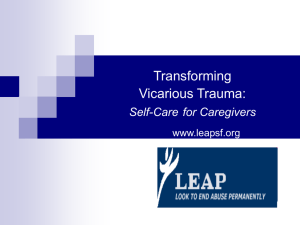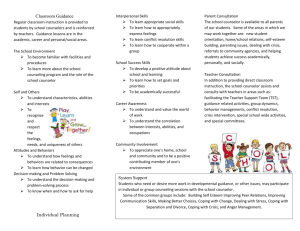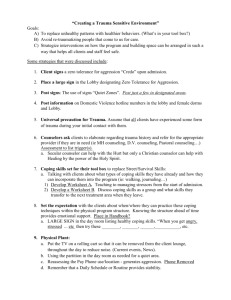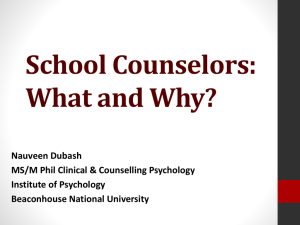Free Sample
advertisement
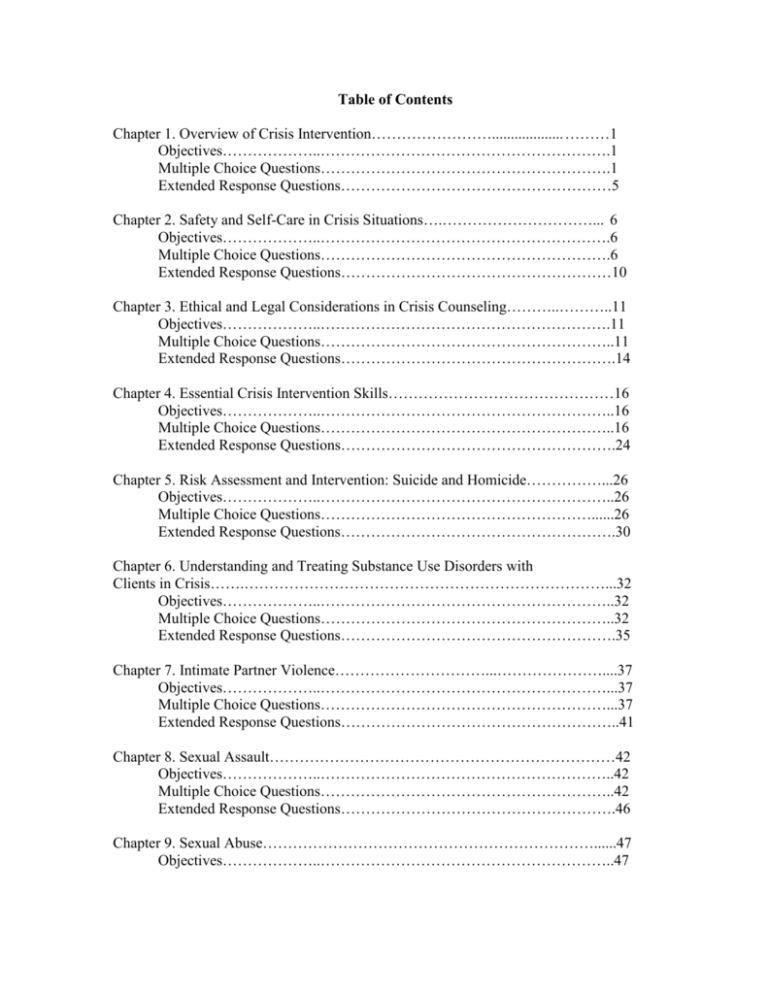
Table of Contents Chapter 1. Overview of Crisis Intervention……………………................... ………1 Objectives………………..………………………………………………….1 Multiple Choice Questions………………………………………………….1 Extended Response Questions………………………………………………5 Chapter 2. Safety and Self-Care in Crisis Situations….…………………………... 6 Objectives………………..………………………………………………….6 Multiple Choice Questions………………………………………………….6 Extended Response Questions………………………………………………10 Chapter 3. Ethical and Legal Considerations in Crisis Counseling………..………..11 Objectives………………..………………………………………………….11 Multiple Choice Questions…………………………………………………..11 Extended Response Questions……………………………………………….14 Chapter 4. Essential Crisis Intervention Skills………………………………………16 Objectives………………..…………………………………………………..16 Multiple Choice Questions…………………………………………………..16 Extended Response Questions……………………………………………….24 Chapter 5. Risk Assessment and Intervention: Suicide and Homicide……………...26 Objectives………………..…………………………………………………..26 Multiple Choice Questions………………………………………………......26 Extended Response Questions……………………………………………….30 Chapter 6. Understanding and Treating Substance Use Disorders with Clients in Crisis…….………………………………………………………………...32 Objectives………………..…………………………………………………..32 Multiple Choice Questions…………………………………………………..32 Extended Response Questions……………………………………………….35 Chapter 7. Intimate Partner Violence…………………………...…………………....37 Objectives………………..…………………………………………………...37 Multiple Choice Questions…………………………………………………...37 Extended Response Questions………………………………………………..41 Chapter 8. Sexual Assault……………………………………………………………42 Objectives………………..…………………………………………………..42 Multiple Choice Questions…………………………………………………..42 Extended Response Questions……………………………………………….46 Chapter 9. Sexual Abuse…………………………………………………………......47 Objectives………………..…………………………………………………..47 Multiple Choice Questions………………………………………………….47 Extended Response Questions………………………………………………51 Chapter 10. Emergency Preparedness and Response in the Community and Workplace………………………………………………………………………52 Objectives…………………………………………………………………...52 Multiple Choice Questions………………………………………………….52 Extended Response Questions………………………………………………56 Chapter 11. Emergency Preparedness and Response in Schools and Universities..……………………………………………………………………57 Objectives………………..………………………………………………….57 Multiple Choice Questions………………………………………………….57 Extended Response Questions………………………………………………61 Chapter 12. Grief and Loss…………………….……………………………………62 Objectives………………..………………………………………………….62 Multiple Choice Questions………………………………………………….62 Extended Response Questions………………………………………………66 Chapter 13. Military Deployment and Reintegration Issues…………………..…….67 Objectives………………..………………………………………………… 67 Multiple Choice Questions………………………………………………….67 Extended Response Questions………………………………………………72 Chapter 14. Death Notifications…………………………………………………….73 Objectives………………..………………………………………………….73 Multiple Choice Questions………………………………………………….73 Extended Response Questions………………………………………………75 ANSWER KEY……………………………………………………………………..76 Answer Key For Chapters 1 and 2…………………………………………………..76 Answer Key For Chapters 3………………………………………………………...77 Answer Key For Chapters 4………………………………………………………...78 Answer Key For Chapters 5………………………………………………………...79 Answer Key For Chapters 6 and 7…………………………………………………..80 Answer Key For Chapters 8………………………………………………………....81 Answer Key For Chapters 9 and 10………………………………………………....82 Answer Key For Chapters 11……………………………………………………......83 Answer Key For Chapters 12 and 13………………………………………………...84 Answer Key For Chapters 14…………………………………………………………85 ii Chapter 1: Overview of Crisis Intervention Chapter Objectives After studying this chapter the student will be able to identify and define a crisis situation. understand the basic theoretical underpinnings of crisis intervention. understand how crisis can play a role in family dynamics and affect individuals. recognize specific elements of stress and how it contributes to crisis. understand how different crises can be developmental in nature and have links to unique ecological determinants. understand that most crisis situations consist of key concepts such as stress, trauma, coping, and adaptation. understand how people can be resilient in crisis situations and how that resiliency plays a role in treatment. understand the various roles of mental health workers. discuss the realities of working in crisis situations. Multiple Choice Questions 1. Crises are A. traumatic events. B. any events that cause trauma reactions. C. events that cause subjective distress. D. None of the above. 2. According to authors such as James (2008) and Slaikeu (1994), a crisis A. is a perception or experience. B. is an event. C. is a situation. D. always leads to a negative outcome. 3. __________ was an early influence in the field of crisis intervention. A. The Great Atlantic Hurricane of 1944 B. The Cocoanut Grove Nightclub fire of 1942 C. Hiroshima and Nagasaki being bombed with nuclear weapons in 1945 D. Orson Wells’ broadcast of “The War of the Worlds” in 1938 4. Early contributors to the field of crisis intervention include all of the following EXCEPT A. Gerald Caplan. B. Gerald Corey. C. Erich Lindemann. D. Reuben Hill. 5. The study of crisis intervention began during World War II in response to 3 A. B. C. D. soldiers returning from the war effort with PTSD diagnoses. family reactions when loved ones left home to participate in war efforts. family reactions when soldiers returned from service and resumed their civilian lives. families grieving for loved ones who died in combat. 6. A cluster of symptoms including somatic distress, feelings of guilt, hostility, disorganization, and behavior changes experienced by the surviving family members of nearly 500 individuals who died in a tragic event in the 1940s was labeled “acute grief.” A disorder that is described in the DSM that seems to parallel acute grief is A. acute stress disorder. B. posttraumatic stress disorder. C. adjustment disorder. D. bereavement. 7. According to Erich Lindemann, a psychiatrist and researcher who described acute grief, treatment for acute grief A. should be provided only by psychiatrists who may prescribe medication. B. may be provided by psychiatrists (MDs) or psychologists (PhDs) but not counselors or social workers. C. may be provided by paraprofessionals and helpers other than psychiatrists. D. is not necessary. 8. According to Raphael (2000), the full impact of trauma frequently is felt A. within 48 hours of a crisis event, during the “fight or flight” period of adjustment. B. two to four weeks after a crisis event during the period of adjustment known as “picking up the pieces.” C. a considerable time after the crisis event during the “disillusionment” period of adjustment. D. after individuals or families have completed the “rebuilding” period of adjustment and can reflect on the events of the crisis in totality. 9. According to Hill’s ABC-X model of crises, A. a crisis is caused by a stressor event. B. as long as there are resources to meet the demands of a stressor event, there will not be a crisis. C. “A” represents an antecedent event, “B” represents behavioral resources, “C” represents the crisis, and “X represents treatment or intervention. D. a crisis is the outcome of an interaction between a stressor event, resources, and cognitive processes involving perception and meaning. 4 10. According to the Double ABC-X Model proposed by McCubbin and Patterson (1982), longterm change following a crisis event A. would most likely be negative. B. would most likely be positive. C. is not likely. D. may be positive or negative. 11. Stressors that may lead to crises A. generally are unforeseen. B. may be normal, developmental phenomena. C. typically originate outside the individual or family. D. most often are traumatic. 12. The effects of a stressor or crisis event may be mediated by A. tangible resources such as food, clothing, and shelter. B. intangible resources such as self-esteem and problem-solving ability. C. external resources such as social support or government aid. D. All of the above. 13. Which of the following statements about coping is FALSE? A. Denial may be a useful short-term coping strategy. B. Coping often involves “fight or flight” responses. C. Using defense mechanisms should not be considered coping. D. Coping involves both cognitive and behavioral responses. 14. According to Boss (2002), stress is mediated by internal and external contextual variables. Internal contextual variables include A. factors over which the individual or family has no control, such as heredity. B. normative, developmental factors. C. factors such as culture. D. factors or dimensions that may be controlled or changed. 15. According to Selye (1956), there are two types of stress, A. affective and cognitive. B. biological and environmental. C. internal and external. D. distress and eustress. 16. According to Boss (2002), __________ is a continuous variable, whereas __________ is a dichotomous variable. A. distress; eustress B. stress; crisis C. organization; disequilibrium D. coping; adaptation 5 17. Which of the following statements with regard to trauma is TRUE? A. Traumatic events almost always involve actual death or serious injury. B. People experiencing traumatic events respond with intense feelings of fear and helplessness. C. Most people who experience traumatic events develop acute stress disorder or posttraumatic stress disorder. D. All of the above. 18. A behavioral or cognitive action that is taken in an effort to manage stress is A. a coping strategy. B. a defense mechanism. C. adaptation. D. a resource. 19. __________ is NOT a category of coping described by Lazarus (1993). A. Problem-focused coping B. Solution-focused coping C. Emotion-focused coping D. Avoidance 20. Following a stressor or crisis event, the degree to which functioning has changed over an extended period of time is called A. adaptation. B. resilience. C. coping. D. None of the above. 21. __________ does NOT have a positive association with resilience. A. Attachment B. Mastery C. Cognitive skills D. Affective arousal 22. Compared to psychologists and psychiatrists, professional counselors A. are less trained and less prepared to provide crisis intervention. B. work from a prevention point of view. C. would not be likely to diagnose mental or emotional disorders. D. are less effective advocates because they have Masters’ degrees rather than doctoral degrees. 23. Within the mental health community, paraprofessionals A. include counselors. B. are not permitted to provide crisis intervention because they are not licensed. C. may provide an outlet for clients to talk and feel less isolated. D. None of the above. 6 24. Which of the following statements is TRUE? Crisis intervention A. usually occurs between counselors and clients who have no previous relationship. B. may be a scheduled component of other forms of counseling. C. is similar to other forms of counseling in its purpose, setting, time, and design. D. may take place within an established ongoing counseling relationship. 25. The procedures for working with clients in crisis begin with A. establishing equilibrium. B. assessment. C. debriefing. D. defusing. Extended Response Questions 1. How does disequilibrium play a role in crisis situations? 2. You are a counselor at a local mental health agency. You have just read the intake of a male client that you will see next week. His presenting problem is that he witnessed his brother being shot and killed. According to the ABC-X model, what might you anticipate while working with this client? 3. In the scenario presented in question #2, describe what you might consider to be the provoking stressor events and how those might be described by the client. 4. Again, in the scenario presented in question #2, describe some of the resources that might be needed while working with this client. 5. In a debate between developmental crisis and situational crisis. Take the side of developmental crises. Make a case for how developmental crises are more difficult to treat than situational crises. Provide specific examples to support your case. 6. In a debate between developmental crisis and situational crisis. Take the side of situational crises. Make a case for how situational crises are more difficult to treat than developmental crises. Provide specific examples to support your case. 7. Discuss how stress and trauma are key concepts related to crisis. Provide specific examples of how clients might experience these concepts. 8. Discuss how coping, adaption, and resilience are key concepts related to crisis. Provide specific examples of how clients might experience these concepts. 9. Discuss how crisis intervention is different from other forms of counseling. Provide specific examples in your discussion. 10. You are in charge of a crisis response team. Your team has been called out to work with individuals and families in the aftermath of a major hurricane. On your team, you have access to professional counselors, psychiatrists, psychologists, social workers, and an assortment of paraprofessionals. Briefly describe how you would use each of these mental health workers in this situation and how you might hope they could collaborate together. Chapter 2: Safety and Self-Care in Crisis Situations Chapter Objectives 7 After studying this chapter the student will be able to: 1. Explain safety and security concerns related to counseling practice particulary regarding crisis situations 2. Describe common precautions that counselors should exercise regarding safe practice. 3. Delineate the difference between burnout, secondary traumatic stress, compassion fatigue and vicarious trauma. 4. Explain the emerging concepts of vicarious resiliency and compassion satisfaction as they relate to counseling practice 5. Discuss self-care as an essential factor in best practice. Multiple Choice Questions 1. During the initial impact of a crisis, A. mental health providers beginning treatment planning. B. mental health providers work independently of the crisis team. C. critical needs such as shelter and food are addressed first. D. triage is not important. 2. Which of the following referral scenarios represents the greatest potential danger to a sole practitioner? A. A client calls after finding your name on an online listing. B. A lawyer you know refers a client to you. C. A former client refers her neighbor to you. D. A psychiatrist refers a client to you. 3. Rapport building in cross cultural counseling may be hindered by A. sensitivity. B. distrust of government agencies. C. collaboration with community leaders. D. resources and aid. 4. A high risk suicidal client suddenly jumps up and runs from a counselor’s office. The counselor should A. call law enforcement. B. run after the client and try to stop the client. C. call the nearest emergency room and ask them to be on the lookout for the client. D. call the client to schedule another appointment for follow up. 8 5. The most dangerous setting for counseling practice is a A. university counseling center. B. sole practitioner in a multipurpose building. C. counseling agency. D. sole practitioner practicing in his or her own home. 6. A sole practitioner who experiences fear or intuitive red flags when screening a new client via phone should A. not discriminate and take on the client. B. seek counseling for anxiety. C. decline to see the client. D. see the client but sit near a door for an escape route. 7. Counselors working with clients at high risk for violence should do all of the following EXCEPT A. secure wall framed items, such as pictures and diplomas, to the wall. B. display family photos in a prominent place. C. avoid wearing ties and scarves. D. install a safety alarm. 8. The majority of stalking cases involve A. female inpatient clients. B. male inpatient clients. C. female outpatient clients. D. male outpatient clients. 9. Regarding in-home counseling. All of the following are true EXCEPT that A. in-home services should be conducted alone. B. counselors should call their agency before and after the in-home appointment. C. counselors should familiarize themselves with the community and environment. D. if a counselor feels uneasy, the counselor should leave the premises. 10. Self-assessment is the process whereby counselors A. underestimate best practice. B. react emotionally to challenges. C. monitor their reactions, behaviors and feelings. D. reject internal process. 11. In addition to self-checkins for mental health monitoring, counselors should also A. ask clients for feedback regarding their performance. B. conceal stress so that they can continue to be role models. C. disclose their concerns to clients. D. debrief with colleagues. 9 12. Crisis intervention can lead to stress and burnout due to A. the emotionally charged environment. B. client resiliency. C. counselor resiliency. D. wellness training. 13. It is __________ to engage in restorative practices. A. to our monetary benefit B. our ethical obligation C. futile D. an indicator of impairment 14. Counselor James has unresolved grief about his mother’s untimely death at a young age from breast cancer. His new client has come to counseling for help with facing her diagnosis of breast cancer. James begins to cry during the intake session. This is an example of A. consultation. B. countertransference. C. transference. D. resolution therapy. 15. Counselors who become aware of unresolved issues should seek consultation, supervision and A. reimbursement. B. licensure. C. personal counseling. D. reactive interface. 16. __________ occurs when counselors exhaust themselves both physically and emotionally over time. A. Resiliency B. Compassion empathy C. Burnout D. Vicarious trauma 17. Disconnected counselors have high levels of client A. adjustment. B. esteem. C. purpose. D. devaluation. 18. Secondary traumatic stress refers to A. the ability to cope with primary trauma. B. behaviors and emotions resulting from trauma stories. C. cognitive burnout. D. stress emphasis. 10 19. __________ involves a changed worldview and sense of self as a result of work with trauma clients. A. Burnout B. Secondary traumatic stress C. Compassion fatigue D. Vicarious trauma 20. While burnout is a response to occupational stress, vicarious trauma involves a personal __________ reaction to a client’s experience. A. behavioral B. affective C. cognitive D. emotional 21. __________ occurs when counselors experience affirming thoughts, feelings and beliefs after hearing about clients’ adaptation to difficulties. A. Vicarious resiliency B. Internal stress C. Vicarious trauma D. Empowerment burnout 22. All of the following are examples of vicarious trauma prevention EXCEPT A. peer supervision. B. training and education on trauma work. C. overtime to gain experience working with trauma clients. D. spirituality. 23. Counselors working with __________ must be especially intentional about self-care. A. the elderly B. adolescents C. a wide spectrum of client issues D. trauma clients 24. The capacity of clients to deal with trauma and restore their lives was found to be __________ to counselors. A. empowering B. overwhelming C. insignificant D. detrimental 25. Counselor well-being is dependent upon __________ to engage in self-care. A. external pressure B. enforced requirements C. intentional choices D. professional organizations 11 Extended Response Questions 1. Discuss the impact of cultural factors on crisis counseling. 2. Relate the three types of referral sources discussed in the chapter and explain the importance of screening with each type. 3. Discuss the factors that indicate a greater risk for dangerous behaviors from a client. 4. What safety procedures can a sole practitioner engage in when seeing a new client? 5. If a counselor works with a population at high risk for violence, what safety steps should the counselor employ to reduce the risk of bodily harm from dangerous clients? 6. What steps can counselors take to reduce the likelihood of stalking by a client? 7. Explain the benefits and risks of in-home counseling and discuss safety procedures that inhome counselors should employ. 8. Discuss the ethical obligation for engaging in self-assessment and self-care. 9. Define and discuss the differences between burnout, compassion fatigue and vicarious trauma. 10. Discuss compassion satisfaction and vicarious resiliency. How do these concepts support self-care? 12 13


